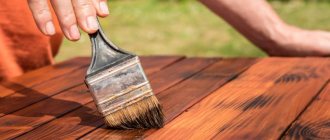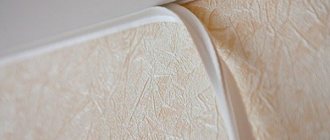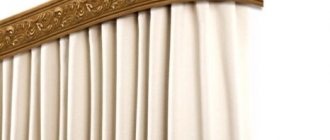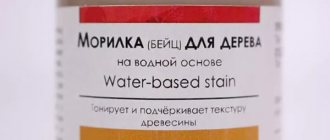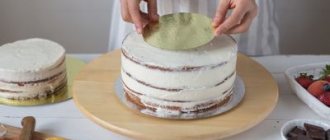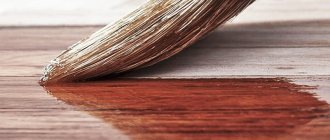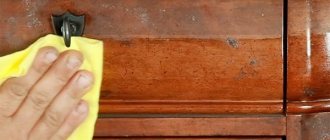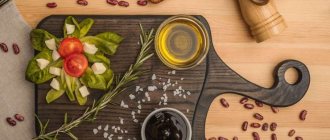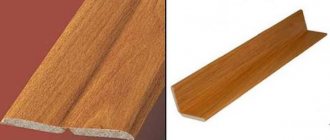Wood stain is a liquid product that helps highlight the appearance of natural wood, as well as protect it from harmful external influences. A special composition can make wood aesthetically attractive, refine it, change the color of the wood, based on the design features of the room.
An aggressive environment, which may include bacteria, mold, various microorganisms and insect pests, has a negative impact on the tree. To minimize the risk of such problems occurring, it is worth taking timely care to coat the wood with special compounds, among which stain is especially prominent.
The liquid substance can set a different color for the surface being treated. This feature helps to refine the natural color of wood or radically change it. The stain allows you to:
- tint wood, preserving its structure,
- reliably protect the material from external influences,
- imitate another, more expensive type of wood,
- protect the material from rotting and destruction by pests,
- combine shades, creating the effect of finishing the surface of different woods,
- strengthen the structure of the outer layer of wood,
- impart partial moisture-repellent properties,
- increase the service life of the material.
When applying stain, a film does not form on the surface of the wood; the substance penetrates deep into the wood without changing its structure or impairing the characteristics of the raw material.
Buy wood stain
|
|
Exterior stain
In addition to the above-mentioned calcpaste, the protective white wax stain Verfijn Steigerhout beits is well suited for whitening external surfaces.
Its use emphasizes the naturalness of the natural surface structure. In addition to the remarkable aesthetic effect, this stain for exterior use perfectly protects the wood surface from blueing and rotting for a fairly long period. Film-forming coatings are also used to bleach wood.
Another whitening product is Sigmalife VS-X alkyd-based exterior stain. This stain, in addition to its immediate whitening functions, serves as a primer and has remarkable protective properties; it will protect the wood surface from bad weather and ultraviolet radiation for a long time. For the best result, apply Sigmalife DS acrylic as the last (finishing) layer or AVIS timbercoat varnish, which is also made on an alkyd base and is of high quality. When using Sigmalife VS-X, the tree will be reliably protected from all environmental aggressions, even if the finishing layer is not applied immediately.
There are many methods and technologies for bleaching wood coatings, and to consider them all would probably require a whole book. This article highlights the basic principle of whitening and shows the means by which it is easier to achieve not just a better result, but one that you would prefer. In addition, each of the considered means has its own special characteristics that are not characteristic of others. Knowing these features will make it easier for you to make your choice for a specific use.
Manufacturers
Choosing a quality product to protect and add a decorative layer to wood is difficult, because there are a large number of products on sale from different brands. But still, some brands stand out among others, and buyers purchase them more often:
- German manufacturers - Caparol, Dufa, Flamingo;
- Turkish brands - Betek, Dyo and Marshal;
- There are also companies from Slovenia that are beginning to actively conquer the construction market, thanks to their high quality - Hellios and Belinka Belles DO O;
- Among Russian companies, Novbytkhim stains stand out.
Staining wooden bases gives high-quality results in protecting structures from various external influences that can lead to destruction of the material.
Staining wooden bases gives high-quality results in protecting structures from various external influences that can lead to destruction of the material. But they also help improve decorative properties by changing the shade of the base. Thanks to the variety of products, you can choose an option for any operating conditions.
Application methods
There are four main ways to apply stain:
- Rubbing painting. The composition is applied to the surface, after which it is rubbed over the entire area. Recommended for use when processing porous wood species.
- Spraying. When staining wood by spraying, a manual or automatic sprayer is used as a tool for applying stain.
- Processing with a foam roller. This method avoids the formation of streaks and helps to distribute the mixture evenly over the entire surface.
- Processing wood with a paint brush. The method allows you to obtain a deeper and richer color of wood, but is not suitable for all types of impregnation.
Next, we will consider in detail how to stain wood. To obtain a high-quality and good coating, you must follow the basic rules for treating surfaces with stain:
- Before painting a surface with stain, it is necessary to remove old coatings from it, and then degrease it better.
- The surface made of coniferous species (for example, pine) must be deresined.
- It is necessary to paint wood with stain and remove excess only in the direction of the wood structure.
- It is recommended to cover the surface with 2-3 layers, while for the first layer a small volume of the mixture should be used.
- After the first layer has dried, the surface must be sanded and the raised lint removed, and then, if necessary, apply subsequent layers (each subsequent layer is applied only after the previous one has completely dried).
The approximate drying time for oil-based impregnations is about three days, and for water-based and solvent impregnations - 2-3 hours (depending on how many layers were applied). It is recommended to divide large areas of the surface to be treated into small areas and paint them in stages. To avoid the possibility of defects forming on the surface, the composition must be diluted. A solvent is used for this.
Plywood stains perform a purely decorative function. Therefore, if you are in doubt about whether to choose stain or varnish, it is recommended to use them in combination. Before covering the surface of the plywood, it must be moistened, and it is recommended to heat the mixture itself.
After covering the wood with stain, it should be treated with varnish (layers should be very thin to avoid the possibility of smudges). The tool you can use is a brush, roller or sponge. Wood varnish will enhance the protective properties of the impregnation. By following these recommendations, you can easily stain wood at home.
Staining
Products are painted with stain in the following order:
- the impregnation should be slightly heated to enhance penetrating power;
- soak the tool in the staining compound and remove excess to prevent drips. When using a spray gun, fill the tank;
- wood should be processed along the grain. A steady, continuous movement of the brush will help prevent stains;
- Use a clean rag to collect excess impregnation;
- wait for it to dry completely;
- Apply another 2-3 layers to achieve the required color saturation.
Stain will help improve the appearance and quality of wood products. It will protect the base from rapid destruction. It is important to choose the right impregnation and carefully study the instructions for use and characteristics of the product. It is also important when choosing to consider what exactly the stain is needed for - to protect or improve the appearance.
Peculiarities
Wood has always been the most popular material; even newfangled materials do not compete with it. Rooms with wooden furniture or decoration using this natural material will always have an advantageous appearance and create a special atmosphere. Wood products require constant care. Using stain you can protect its surface from the following factors:
- from high humidity;
- from external factors that adversely affect the surface;
- from exposure to direct sunlight;
- prevent dirt and scratches.
Wood stain penetrates into the material without leaving a layer like regular paints do. Applying stain allows you to quickly change the color of the product, give it a more interesting look, and emphasize the structure without overlapping it. Today, stains have already appeared, thanks to which it is possible to increase the use of wooden surfaces; moreover, they do not have disinfecting properties.
Using different stain colors to create beautiful effects
The use of various combinations and color combinations, as well as application techniques, allows you to achieve interesting decorative effects. For example, the rubbing method is used to create a realistic imitation of noble breeds during the dyeing process. For this, stains with a hint of oak or pine are suitable. It is not recommended to select quick-drying compounds for these purposes.
If you want to create a memorable interior, they resort to tinting the wood with concentrated bright colors. To get a rich tone, you will need to mix several shades (two or more). As a result of mixing mahogany and blue stain, a purple stain is obtained. The same shade can be achieved by combining ebony and mahogany. A mixture of marigold and plum gives a mocha color. A similar effect is obtained by mixing rowan and walnut.
Colored stains look very unusual in the interior of a room. To get this effect, you need to cover the tree with the main background. After this, stains of other colors are applied with strokes. A colorless varnish composition is used as the finishing layer.
A huge range of stain colors allows you to create updated interiors
If you combine black, burgundy and blue stains in one interior, you get quite interesting combinations. Burgundy furniture looks very impressive in a room with blue wooden floors.
The list of options for decorating rooms using stain does not end there. A huge range of colors allows you to create countless combinations and secondary shades, which significantly expands the design possibilities of these impregnations.
Formation of stains during staining and how to avoid it
Such a flaw appears due to the unevenness of the wood structure; the stain may not penetrate the surface equally deeply everywhere. As a result, individual stains may remain on the base; to avoid this, you need to use a special conditioner. It is applied as the first layer and closes the pores, the next layer is a gel that does not spread.
Individual stains may remain on the base; to avoid this, you need to use a special conditioner.
Adviсe
Working with stain is easier than working with paint, but even here you can create smudges and stains. If the wood has any defects or covered cracks, then such defects will become clearly visible.
Algorithm for applying stain:
- The surface must be clean. If there is any exposed tree resin or oil stains, they must be sanded and degreased.
- Some types of wood absorb moisture well. To reduce stain consumption, you can pre-moisten the surface. This technique will also reduce hairiness after staining.
- Beitz must be shaken or mixed thoroughly. If the diluted composition turns out to be cloudy, then it should be filtered through a thick cloth or cotton wool filter.
- You can apply stain with a brush, foam rubber, roller, spray or cotton swab. It is necessary to stain along the grain. If you “pour” a lot of liquid, unsightly smudges may remain. When painting a vertical surface, it should be applied from top to bottom.
- If there are several layers, then each subsequent layer should be applied after the previous one has dried (after 4-12 hours). The finishing layer dries up to a day.
When you need to treat a large area, you can first use a cheaper composition, and purchase a higher-quality stain for the finishing layer, thus saving on price.
If stains or smudges have formed, they should be washed off with water or gently wiped off with acetone. In some cases, only sanding will help. After this, apply another 1-2 layers of stain.
When a product is assembled from different types of wood, after staining the areas may differ in color, even if there were no differences in them initially. This must be taken into account, otherwise the product may be damaged. In some cases, it is better to use paint or varnish instead of stain.
The shade purchased may differ from the sample upon application. To predict the result, you need to apply stain to a block similar to wood, and at the same time select the desired shade and decide on the number of layers. If there is no bar, then you can apply it to an area where it will not be visible. For example, when working with a wooden chair, you can use the space under the seat or the inside of the leg. An unsuccessfully chosen color can always be corrected with a darker shade.
For more information on how to work with water-based stain, see below.
Dealing with defects
It happens that the stain is applied to the surface incorrectly. Here are the main ways to eliminate defects:
- For numbness. Immediately after tinting the wood, you need to cover the area with varnish, which will dissolve the stain. Then clean the treated area with a rag. When the drip has already dried, it will have to be softened with white spirit or ground off with sandpaper.
- For stains. If we are talking about plywood, you will have to remove all the veneer using a plane. Solid wood is also processed with this tool, removing the thin top layer.
How can I remove stain?
The easiest way to remove water stain from your hands or treated wood. Of course, you can only remove the top layer, because such stains are distinguished by deep penetration. Stained clothes can be washed with regular powder, then rinsed with conditioner. If necessary, use oxygen bleaches, and chlorine bleaches on white items.
If stain gets on linoleum, wipe off the stain with acetone or white spirit. You must work carefully so as not to discolor the surface of the material. You can get rid of stain stains on the skin using vegetable oil or by frequently washing your hands with soap. It is much more difficult to remove non-aqueous types of stains from surfaces; you will have to remove the top layer of wood along with the tinting coating.
Application Tips
The most effective and simplified method of applying stain is spraying. This technique is considered to be of very high quality, since the coating in such cases lies on the surface as evenly as possible. Using this method, you can coat both regular wood and plywood.
If the wooden product is not large in size, you can spread colored stain over it using a roller.
A brush is also a popular method of coating, but it is not always suitable for quick-drying solutions, since they can leave streaks behind if the surface is not painted as quickly as possible. It is difficult to say which coloring method is right for you. Here you should proceed from what material you will be covering, and what composition of stain you will use.
- When diluting and applying this or that mixture, be sure to read the instructions that come with the product. Do not forget about safety precautions and be sure to use protective gloves.
- The number of layers of stain will depend on how intense the shade you want to achieve.
- When processing wood, especially when it comes to coniferous species, do not forget that it must first be deresined. Also, many experts believe that it is best to apply stain along the grain of the wood.
- Powdered mixtures should be dissolved only in clean and distilled water.
- In order for the stain to penetrate as deeply as possible into the structure of the wood, many professionals recommend heating the ready-made mixture. Some stains are added to varnishes for painting wood. The same effect is obtained, but with improved protective properties. However, this technique does not work with all types of stains. Information on this issue should be clarified with store consultants.
To learn how to choose a stain for interior woodwork, see the following video.
Varnishing plywood ↑
In terms of surface preparation, there is not much difference between painting and varnishing: you also need to sand the plywood, prime it and cover it with paint and varnish. Before applying the composition, it is necessary to thoroughly clean the surface of dust and small particles that have settled after grinding.
It must be taken into account that the varnish, whether matte or glossy, is transparent - the wood texture, knots will be visible, and putty cannot be used. They varnish flawless plywood - without voids, recesses, or other defects. Varnish can also be used to add gloss to a painted surface.
Don’t forget to read the instructions on the can of varnish - follow the manufacturer’s instructions: dilute the composition as the manufacturer advises, mix thoroughly; Follow the recommended time intervals. If after stirring you need to let the composition sit for several minutes, do not neglect this requirement: the varnish is allowed to stand so that the air bubbles leave the composition when it reaches room temperature.
The plywood is varnished in several layers, drying each one. The layer is applied thinly so that drips do not form. To increase adhesion, a layer of varnish (before applying the next one) is passed with a fine abrasive and thoroughly cleaned of the resulting dust.
Important! Remember your health. Wear gloves and a respirator. A draft is undesirable for drying paintwork, so ventilation of the room should not be used as a safety measure.
Water-based wood stain and alcohol stains
Water-based stains are the most environmentally friendly stains. They do not have a strong unpleasant odor and are easy to use.
Related article: Homemade motorcycle lift from a jack
This product can be sold as a dry or ready-made mixture. Such dyes are most popular due to their low price and the possibility of their use for both interior and exterior work.
Water-based wood stain can significantly improve the appearance of wood flooring
Main characteristics of water stain:
- The colors of water-based stains are very diverse. With their help you can create a very interesting iridescent effect.
- You can use water sprays without fear for your health. Even at the highest temperatures, such products do not emit harmful fumes.
- If you decide to experiment and are wondering: “Which stain to choose so that it can be washed?” – then water stain is what you need. This tinting agent can be easily washed off with water, so painting the floor with it is impossible.
- Tinting a wooden surface with this method makes its texture more noticeable. Unfortunately, this makes the product more sensitive to moisture, so it will need to be opened with varnish.
It is extremely undesirable to tint resinous tree species with such impregnation, as unsightly stains may appear on them. For such products it is better to use alcohol impregnations.
How long does alcohol impregnation take to dry? Almost a few seconds! This property is both an advantage and a disadvantage. Thanks to it, you can cover the butt of a sporting rifle with alcohol stain, and use it in just a few minutes, however, a large area can only be stained with a spray gun, otherwise the surface of the product will become covered with unpleasant stains and stains, and even varnish will not help correct the situation. The alcohol impregnation consists of alcohol and dyes.
Treating wood with this impregnation will make it more resistant to ultraviolet radiation and high humidity. However, due to the unpleasant odor of this product, working with it is only possible in an open space.
Applying stain
When painting, you should adhere to the correct technology. Wood placed vertically is painted from bottom to top. This will prevent splashes from getting onto clean areas and will not leave stains in the future.
The horizontal arrangement of the boards requires painting at the first stage along the grain. Next, move the brush across them and, at the third stage, repeat the initial movement.
You can use a spray gun, a brush or a foam swab. The first option is suitable for large areas, as well as for alcohol- and nitro-based stains. The nozzle does not exceed 1.5 mm.
Brushes can be made with natural or synthetic bristles. Natural fiber is good for oil-based stains, while synthetic fiber is good for water-based ones.
Before use, the brush should be checked for strength. If, upon contact with it, no lint remains in your hand, then the product is of good quality and suitable for dyeing. The width of the brush should be 100 mm.
Water stains are applied, in addition to the two already described, with a swab or rag. The material should not crumble or leave marks on the wood, so you should choose cotton or foam rubber.
The wood absorbs the dye exactly as much as it is needed. You don’t have to worry about there being an excess, you just need to remove the excess liquid with a napkin. The stain may look completely different after drying and the color turns out to be an order of magnitude lighter. In order not to take risks and get the desired result, you need to take a piece of board and make a test.
To do this, sand it and cover it with the first layer - this will be the base. After complete drying, apply the second layer to part of the board. Apply the third layer to the remaining part.
When the paint has dried, coat the entire surface with varnish. Now you can decide on the color. The test is considered relevant for coniferous species, since they do not absorb stain well and a problem with the color may appear. The minimum number of layers is at least two. It’s a good idea to prepare several samples with different colors.
Water-based stain has the ability to straighten wood fibers. After complete drying, additionally sand the boards with fine-grain sandpaper, but without much pressure.
Drying time from 15 to 24 hours. Alcohol stain works differently. It will not lift the fibers, but it dries very quickly and forms streaks, so for uniform coverage it is better to use a spray gun.
If using a brush, first moisten the surface with warm water. This also applies to the end parts of the board. They should be wetted, as they absorb a lot of paint, which will make them look darker. Drying time from 5 to 25 minutes.
Work algorithm:
- the surface is sanded before painting; - clean off greasy stains, if spruce or pine - resin. You can use water (370 ml) in combination with acetone (125 ml). Method 2. Add 25 g of caustic soda to 500 ml of water. Method 3. In hot water (500 ml), approximately 60 degrees C, dissolve 25 g of sodium carbonate. Carefully treat the surface with one of the resulting mixtures and leave for 30 minutes. Wipe dry with cotton material. Now walk again with clean water, preferably heated; - slightly warm up the stain; — do not wet the swab too much and apply it to the wood; - if drips appear, carefully stretch them along the surface along the fibers; — the number of layers depends on the selected color on the test board; - as soon as the board is dry, wipe the board well with cloth. It will remove dried dye that did not get into the pores of the object; — the final stage is coating with varnish in several layers. After each layer sanding.
Wood can be painted in different colors. Today, “bleached oak” is considered a fashionable color. In order to obtain this effect, 2 types are used. The first layer is a white stain; it whitens the wood.
Moreover, the dye is water-based. The second type on a wax base is the next layer. Not the other way around. Since the wax stain is oak, it will not be possible to achieve the desired effect.
The stain color of the top layer can be any: brown, black, gray. Only the annual rings will be colored, the field will remain snow-white. The photo shows different types of stains. Their contrast is clearly visible here.
How to make stain yourself?
Some craftsmen prefer to make wood tinting solutions using their own recipes. Below we will present several options that are quite accessible for making at home.
In order to achieve a certain shade of wood, various plant and chemical compounds are used.
1. To give the wood one of the brown shades, thick infusions of tea or coffee can be used.
Strongly brewed tea contains tannins that can change the color of light wood.
- To make a stain from tea, a thick brew is made from it, which is filtered after cooling. The composition is then applied to the wood, and thanks to the tannins contained in the tea, the wood acquires one of the many brown shades. The color saturation will depend on the concentration of the tea leaves made.
- Coffee is used in much the same way as tea. Its ground grains are brewed, infused and filtered. The intensity of the color will depend on the strength of the prepared solution. In order to achieve a certain shade of wood, a small amount of soda is sometimes added to coffee. The proportions of the ingredients are 1:4, that is, 4 parts coffee to 1 part soda.
2. Walnut shells and partitions, crushed, boiled and strained, also provide a solution that will give the wood a brown tint. Sometimes soda is added to the composition. If it is necessary to achieve a red-brown tint, then potassium dichromate should be added to the decoction. 3. In order to achieve a reddish tint to the wood, an infusion of larch bark or onion peel is used.
Larch bark is an excellent natural ingredient for making wood stain, which gives wood a reddish tint.
4. Black stain can be obtained by using a decoction made from the bark of alder, willow, oak, and walnut shells to treat wood. All of the above ingredients are poured with water, brought to a boil, after which ½ teaspoon of soda is added to the broth, and it should boil for another 10 minutes.
To obtain the “ebony” effect, the wood is coated with a tincture made from acetic acid, to which metal elements, such as nails, are added. This solution should be infused in a dark place for seven days.
Buckthorn berries and bark are used to tint light wood.
5. To obtain a golden hue, use a decoction of buckthorn berries. 6. The gray color of wood can be obtained by applying acetic acid to it. 7. Wood fibers will turn cherry when a thick solution of magnesium permanganate is applied to them. To make it you will need 50 grams. powder, which are added to one liter of heated water. 8. Greenish tints of wood can be obtained by using a mixture of vinegar with 50 grams of copper sulfate, which should be boiled for 15 minutes before application. 9. Blue tones are achieved by mixing red elderberries with baking soda. 10. The tree acquires a bright orange color when tinted with a decoction made from poplar shoots - 150 grams of raw material per liter of water. The mixture must be boiled for an hour, then it is filtered and left in the light - after which it turns orange. 11. If you add alum to any of the above solutions, you can get a more intense color of the coating. 12. Heated cotton oil can give wood a dark shade and highlight its textured pattern. In addition, this composition will significantly strengthen the material. 13. As mentioned above, whitening compositions, which can also be made at home, have become very popular. A remarkable fact is that when applying bleaching compounds to different types of wood, you can get the most unexpected shades. For example, walnut has natural purple hues, so when a bleaching solution is applied, it may take on a pinkish or even bright scarlet color. The shade will depend on the amount of natural pigment in the wood. When apple wood is coated with bleach, it will acquire a delicate ivory shade.
Next, several whitening recipes will be given.
Oxalic acid is sold in the form of crystals.
- Oxalic acid. You only need 5 grams per 100 milliliters of water. This composition is used to bleach light wood. This solution is not suitable for dark wood, as it can leave unsightly stains. After application and obtaining the desired effect, the wood should be washed with a composition that includes 15 grams of lime and 3 grams of soda per 100 milliliters of water.
- Hydrogen peroxide is used to bleach all types of wood, except rosewood and oak. There is no need to rinse the wood after applying this substance.
Making homemade stain is not at all difficult, but in order to achieve the desired shade you will have to experiment, since it is unlikely that you will be able to “hit the mark” right away, that is, get the desired tone. Having prepared the solution and remembering its proportions, the stain is applied to a small area of wood and wait until it dries until the final effect appears. If the shade turns out to be too light, you need to apply a second layer of the solution.
When performing experiments, precautions should be taken, especially if the recipes use toxic substances or acids. It is recommended to work with them in a well-ventilated area or, if possible, outside. You should not neglect skin and eye protection - gloves and goggles.
For the final exterior coating of stained wood, it is best not to use polyurethane varnishes, as they may curdle. Therefore, in this case, nitro varnishes are more widely used.
Video: Demonstration of the recipe and process for preparing stain at home
What are the types
The products differ in their composition components, technical and operational characteristics. Depending on the chemical formula, they are used for interior and exterior work.
Water-based stain for porous surfaces Aquacolor, color – pine wood
Water
Stains of this type are made on the basis of water. Available in two forms: ready-to-use and dry. The color range is varied. After application to wood, it is possible to enhance the natural tone of the natural material, lighten or darken it. It takes 4-14 hours to dry. The process is quite long, but it is necessary for complete evaporation of moisture.
The aqueous composition penetrates deep into the wood structure, resulting in reliable protection against rotting. Other advantages of impregnation include:
- environmental friendliness (can be used even in children's rooms);
- no unpleasant odor;
- the ability to wash off before drying;
- easy change of tone in subsequent treatments;
- hiding wood fiber defects.
The tinting effect is so impressive that many people choose colorless varnish as a decorative coating.
With all the advantages of water stain, there are also negative sides. This coating does not provide moisture-resistant protection. Therefore, it is not recommended for use on street objects.
Wax
Developed on a wax basis. The principle of operation is different from other types. The active substances of the composition do not penetrate deep into the structure, but remain on the surface, creating a water-repellent film. The tree acquires moisture-resistant properties. The effect is so great that a wax-based product is used to treat wood surfaces located in saunas, steam rooms, and baths. It can also be used to protect street structures.
Wax stain is applied as a base before varnishing or painting. This preparation eliminates the formation of stains or unevenness after coating the wood with paint and varnish.
Oily
To make oil stain, synthetic and natural oils and dyes soluble in drying oil (white spirit) are used. This composition has a number of advantages over other types:
- there is no unpleasant odor;
- thanks to tinting, you get a beautiful and durable color that does not fade for many years;
- no toxic substances are used in the manufacture of impregnation, which indicates the environmental friendliness of the coating;
- A moisture-protective layer is formed on the surface of the wood, preventing liquid from penetrating into the structure.
The properties of oil stain are used to treat furniture, floors, parquet and other wood surfaces indoors. The material is not suitable for outdoor use due to its low resistance to UV rays, unless special substances that protect against ultraviolet radiation are used in production.
Acrylate stain Tikkurila Pirtti Panel Stain
Acrylic
Impregnation is available in liquid form. The color palette is impressive: almost all tones are found, identical to different types of wood. Acrylic compositions are distinguished by the absence of toxic substances, quick drying, and reliable protection from moisture, ultraviolet radiation and rotting. After application, no smudges, stains, or stains form on the surface. The coating turns out perfectly smooth.
Acrylic stain does not have a strong odor. The product is considered safe for people, animals and the environment.
Alcohol
The composition is based on alcohol or an organic solvent. A sign of the presence of the second component is the prefix NITRO in the name. The product is available in ready-to-use form or in powder, which must be dissolved in alcohol/white spirit before applying to wood.
The peculiarity of the stain is quick drying. It only takes 5-30 minutes for volatile substances to evaporate. It must be applied quickly; it is recommended to use a spray gun or spray gun for the job. To dilute the thickened alcohol stain, you need to add a little solvent to it.
Purpose: outdoor work. It is not recommended to use the product indoors due to its high toxicity.
| For interior work | For outdoor use |
| Wax | Alcohol |
| Water | Wax* |
| Oily | Oil* |
| Acrylic |
*For outdoor use, stains are selected that contain special substances that increase resistance to UV rays.
Review of the best compositions
Now let's look at the TOP 10 best formulations presented on the Russian market.
Profilux
Profilux stain
is an alcohol-based stain with moderate consumption (120-150 ml per 1 square meter). The liquid is sold in several colors, has good technical properties and dries quickly. The main disadvantage is that it has an unpleasant odor, so it is recommended to use it outdoors.
Vixen
Wood stain Vixen
Liquid is made on the basis of alkyd and natural resins, which ensures good technical properties of the stain and complete environmental safety. Vixen sets very quickly (in 20-30 minutes), but has a high consumption (200-2500 ml per 1 square). Therefore, the composition is recommended for use for finishing furniture.
KolerPark
Universal KolerPark
Universal acrylic stain, characterized by low consumption (100 ml per square), completely resistant to water and sunlight. The liquid has a lot of colors and shades, which allows you to choose the optimal liquid for your tree. A universal stain for household needs - from tinting doors to restoring antique toys.
NOVBYTHIM
Alcohol liquid NOBBYTHIM
Another alcohol liquid that enjoys well-deserved popularity among Russian craftsmen. Thanks to additives, the liquid is characterized by reduced toxicity, and if necessary, such stain can be washed off with a solvent. It has low consumption (up to 100 ml per square meter) and good water-repellent properties.
TIKKURILA
Cheap water stain TIKKURILA
Cheap water stain, which is useful for finishing furniture and wooden surfaces inside the house. It has good stability and low consumption, dries quickly, and does not deteriorate for a long time during storage. The stain has many colors and shades, which will allow you to choose the liquid for the needs of the master. A good choice for finishing a cottage and inexpensive furniture.
Minwax
Quality Minwax
A demanding but quality oil-based stain. The oil tolerates exposure to sunlight and water well, and stains based on it are suitable for any type of wood. The composition takes a long time to dry, and at least 10 hours should pass between applying layers. Minwax is an excellent choice for finishing expensive furniture and wooden houses.
Attention! When choosing, look at the date of manufacture - recently there have been more and more cases of Minwax oil sealant being sold with an expired expiration date.
"Smart repair"
Cheap “Smart Repair”
Cheap water stain, which thanks to additives dries very quickly (you can start applying a new layer after 1 hour). It is not friendly with water and sunlight, so it is recommended to paint furniture, doors, and thresholds inside the house with stain. Another characteristic feature: moderate consumption - only 100 ml per 1 square.
KRAFOR
Quick-drying stain KRAFOR
Quick-drying alkyd stain, adapted for hardwood. It dries within 10-20 minutes, so the composition is ideal for quick application. It has a relatively high consumption (120-150 ml per 1 square) and is expensive, so it is recommended to buy it for finishing furniture and external surfaces of the house.
LIBERON
Universal LIBERON
Universal acrylic stain for all types of wood. It is also distinguished by relatively high consumption (up to 160 ml per 1 square), but good technical properties - excellent water resistance, complete resistance to light, a variety of shades. A good choice for painting any surface - from furniture to the exterior of the home.
Latek
Economical Latek
An economical, cheap, water-based stain that takes a long time to dry, but has good resistance to water and light. It is characterized by low consumption (80 ml per 1 square meter), sold in the form of powder and ready-made liquid. An excellent choice for exterior decoration of cottages and country houses, as well as for decorating old furniture.
What colors are wood stains depending on the type of composition?
The palette of available shades depends on the type of composition. The colors of water-based wood stains are very diverse. Manufacturers claim that such compositions can give the surface any shade. However, the palette of water stains mainly covers natural colors. This includes brown tones in dark and light shades. When treating the surface, water stain lifts the fibers of the material. Thanks to this, its structure becomes clearer and more pronounced, although the degree of protection from moisture is significantly reduced.
For very soft woods, many manufacturers offer special gel stains
Acrylic stains, which are a type of water stain, have the most extensive palette of all existing products. It's all about the improved composition, expanding the decorative capabilities of these solutions. Unlike water-based wood stains, the colors of acrylic stains can be more exotic and atypical. Such inlays emphasize the structure of the material without lifting the fibers. Wax stains, which also come in a wide range of colors, have similar properties.
Among acrylic stains there are also colorless compositions. Such impregnations are produced by. The color of the wood stain in this case will depend on the color that is added to the solution. The Tikkurila Pirtti stain palette includes 36 different shades.
Modern generation materials include stain-gels. Like wax products, they have a thick consistency and are applied to the surface using tampons. As for the palette of gel stains, it is very limited.
Alcohol stains are characterized by good color variety. However, due to the pungent odor of interior finishing, consumers prefer water-based stains, and for exterior work, oil-based compounds with an impressive range of colors and rich shades are often used.
Today, stains are presented in a huge assortment
Color range of wood stains and the effect of the composition on the material being painted
Water-based wood stains come in a wide range of colors. These compositions make it possible to quickly and easily give a wooden surface an expensive and noble shade or radically change the appearance of the material.
The palette of wood stain colors can be divided into three groups:
- Neutral colors - this includes all shades of white, black and gray.
- Natural color range - includes natural shades of wood that are found in nature, for example, the color of wood stain for wenge, walnut, maple, oak, cherry.
- Exotic colors - used to give wood atypical shades, such as blue or purple.
This table contains information about what colors wood stain comes in.
| Color name | Coloring result |
| Beech | Natural shade, warm and emphasizes wood grain well |
| Oak | Dark tone brown |
| Ebony | Creates a visual effect of aged wood, emphasizing the relief of the material and its natural lines |
| Cherry | Can give the surface a rich shade of dark burgundy or paint it in light red tones |
| Fern | The wood takes on a pleasant green tint |
| Mahogany | After drying, the treated surface becomes brown with a slight shade of red. |
| Black | Used to create an aging effect |
| Rowan | Lightly tints the material to a pale pink or transparent beige shade |
| Mocha | The painted surface becomes coffee-colored |
| Bog oak | Gives a matte effect to natural color |
| Hazelnut | Externally similar to a nut shell, used to deepen the structure of the material |
| Blue | Matches the color of wolfberries |
| Ash | After staining, a slight pinkish tint appears on the surface. |
| Larch | Available in a wide range of shades, from dark yellow to orange |
| Maple | Delicate shade of peach color |
| Lemon | Yellow, which can be made contrasting by repeated application |
| Plum | Dark pink color |
| Wenge | Dark shade of brown with black veins and inclusions |
| Bleached oak | White shade |
| Light walnut | Used to protect wood while preserving its natural color |
| Red tree | Noble red color |
| Kaluzhnitsa | The treated surface becomes darker |
| Pine | Transparent, virtually invisible coating |
Color palette
Stain for wood comes in a variety of colors, this makes it possible to get any version of a wooden base; sometimes they resort to applying stain to make the material visually more noble. Often the shade of the surface is uneven, somewhere it is lighter, where there are dark areas, so the solution is distributed among the zones, applying more product in the desired areas.
The color range includes any shades - red, green, black, etc., but woody colors, which are named the same as the species, remain popular. For example, stain color walnut, mahogany and others, if you still can’t choose an option, then it is permissible to mix different shades with each other.
It is worth knowing that shades of the same colors may vary from manufacturer to manufacturer. Therefore, it is required to request a sample palette before purchasing.
The level of color coverage depends on the type of wood. Coniferous types are distinguished by the presence of resins, which prevents good absorption of the stain, so the change in coating will not be so bright, but deciduous types, on the contrary, quickly and efficiently absorb the solution.
To get a lighter tone after coating, you will have to paint the surface; it would be optimal to apply special lightening compounds. When the surface is exposed to moisture during operation, it is recommended to use wax, acrylic, and oil products.
Some lightening stains are considered colorless, so you cannot expect to change the shade; a layer is applied to serve as protection from external environmental influences. But in most cases, staining is chosen not only to extend the durability of the material, but also to paint the product so that it fits into the interior.
The colors are varied, this makes it possible to get any version of the wooden base.
Varieties
You can cover absolutely any wood surface with stains - pine, oak, maple, birch and so on. But you still need to know the types of this product, because each type of stain has certain properties.
Water
The presence of water in the composition of the stain is considered the main constituent ingredient. The group of water-based impregnations is considered the largest. Typically, these products are prepared in finished form or in powder form. The powder can be diluted in water independently according to the attached instructions.
Positive traits:
- Due to the fact that this product has a neutral base, it does not have increased toxicity and does not have any harmful effects on health;
- Availability of a wide range of shades with natural texture. Using these types of products, you can create shades from the lightest to deepest, which will help recreate a natural look and deepen the tone. This quality also gives the surface an expressive and noble appearance;
- It is easy and simple to apply, with minimal product consumption;
- Suitable for any type of wood - pine, birch, oak, maple, walnut, cherry;
- Not high cost.
Alcohol type stain
This product is available in the form of aniline dye, which is dissolved in denatured alcohol. This type of stain is sold both ready-made and dry in powder form, which must be dissolved.
This product has the advantage of drying quickly. However, this quality provides some qualities when manually applying the mixture to wood; after drying, greasy stains often form. Therefore, many builders recommend using a spray gun when using alcohol products.
Oily
In these products, all oil pigments are dissolved in solvents or White Spirit. This composition provides a number of advantages to this type of stain:
- When painting, it provides tinting of wooden surfaces in various colors;
- Oil mixtures are convenient to use at home;
- The composition adheres well to the surface and can be applied with any tools;
- The oil stain evenly enters the area of the wood structure, while forming a protective film on the surface.
Acrylic and wax
Wood stain, which is made from an acrylic or wax base, is new to the construction market. This product has proven itself positively among many consumers and professional builders. This is due to the fact that this mixture, after application, creates high protection for the base from negative influences and premature wear.
Features of the composition:
- After application, this type of impregnation forms an insulating film on the surface of the wood, through which moisture and other negative substances do not penetrate;
- Various color characteristics. Compared to other varieties, this composition has a variety of colors from natural to bright exotic tones;
- These types of stains are used by many modern furniture designers. These products are used to paint the external facades of cabinets, tables, and chairs made of different types of wood.
With whitening effect
It is not always necessary that the wood be dark in color; sometimes it is required that, on the contrary, it have a slightly whitish color. In these cases, impregnations based on hydrogen peroxide and acids are suitable. With their help you can get a light, bleached color of wooden beams. Typically, these solutions are used to prepare the surface for further painting.
Stain is simply a necessary thing to improve the quality of wood. This product protects the base from rapid wear and destruction. The main thing is to choose the right product and carefully read the instructions and characteristics of the composition. But which mixtures to choose all depend on what they will be used for - to improve color or for protection. It is better to first study the properties of each type of stain.
When using wood in your home interior, you think about how long it will last. The answer depends on whether you know how to choose stains and varnishes for interior woodwork. It is also worth considering further use: for furniture, choose non-toxic compositions, for flooring - abrasion-resistant ones.
Video description of choosing a stain
Selection of stains
The choice of stain for indoor work depends on the type of surface and purpose. For painting furniture, non-toxic compounds without a strong odor are chosen, and for flooring, they are highly resistant to abrasion.
Also, when choosing any fighters, you must consider the following:
- Color code . According to the international classification, each color is assigned a specific designation. But in practice, each manufacturer uses its own labeling. Therefore, for large volumes of work, it is necessary to purchase compounds of only one brand.
Example of a paint color palette
- Type of wood . Some types of wood have one unpleasant feature. After applying the stain, clearly visible stains appear on them. Most often, soft varieties behave this way, for example, spruce or pine. To paint them, it is recommended to use oil or wax stains, which apply as smoothly as possible, without leaving streaks or stains.
- Additional effects . The range of modern stains is quite wide. Among them you can find coatings that create the effect of antiquity, metallic, with mother-of-pearl or frost.
Adviсe
When applying stain to a surface with your own hands, you should know how to do it correctly and listen to the advice of experienced craftsmen.
- First of all, any surface should be prepared before applying the product. To do this, the product or surface is inspected, dirt and dust are removed. If it is necessary to remove the old coating, then the surface should be cleaned, the previous layer, chips, and defects should be removed.
- After cleaning, apply white spirit and degrease the surface. If work is carried out on coniferous wood, it is treated with a special compound to remove resin and ensure good adhesion. When using a water-based stain, the wood product should be wetted, and when the fibers rise, sand again.
- In order to understand what the color will be on a certain surface, a color test is done. A little stain is applied to a small area, often hidden from view, and wait until it dries completely. Next, apply another layer if the color is not saturated enough.
- If store-bought stains are not suitable, you can make your own. One of the most common methods is to prepare a solution using strong tea or coffee. Depending on how rich the composition is planned to be, the amount of tea or coffee depends, and for a lighter shade the infusion can be diluted. After this, you can apply the infusion to the surface and adjust its saturation.
- When applying stain, there is no need to use special tools; you can use a regular brush or roller for the job. To apply the alcohol composition, it is better to use a spray bottle, since this composition dries very quickly and stains may remain on the surface.
- It is better to use a roller or swab when applying the product to a small area; thanks to this application, the stain will evenly penetrate deep into the area and create a protective layer.
- The most common tool used is a brush; this tool is easy to work with. When applied with a brush, the stain spreads easily and evenly in the desired direction, thanks to which you can give certain areas different color intensities and play up the pattern.
- The product is painted along the fibers to emphasize the design and reduce stain consumption.
- The composition should have a convenient consistency. When choosing a non-aqueous stain, it should be diluted with white spirit to the desired thickness. Here you cannot do without the specific smell of the solvent.
- The number of application layers is determined individually depending on the desired effect. Usually 2 or 3 layers are applied, after each application the surface is dried.
It is better to make the first layer thinner; the surface must be treated carefully. Such a uniform layer will be the basis for further application. Water and alcohol solutions require 2 or 3 hours to dry; oil solutions require up to 3 days.
By following the tips and recommendations, you can easily complete the job and apply stain to the surface.
Why do you need to prepare the base?
For uniform toning, you need to prepare the surface of the product. Only processing a dry, clean and smooth surface (ideally sanded) gives a uniform color when stained. For sanding in two stages, first use 120 grit sandpaper, followed by fine 180-240 grit. The grain size is selected depending on the breed.
Before using stain on conifers, they are deresined. Greasy stains are wiped off with alcohol or acetone dissolved in water in a ratio of 1:3.
The resin can also be removed with a 5% caustic soda solution. After applying the warm composition, leave for 30 minutes, then wipe with a damp cloth and wipe dry.
The wood is not primed before staining.
